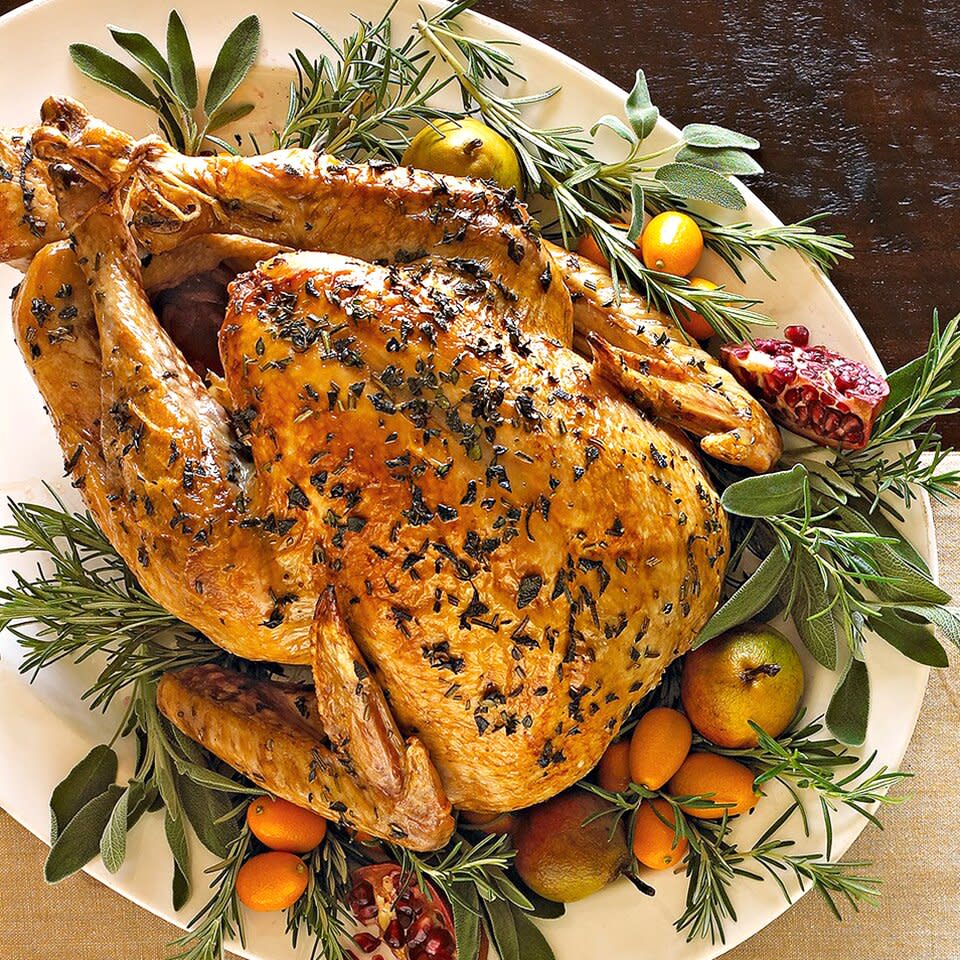How to Roast a Turkey

Every year, the EatingWell Test Kitchen cooks at least half a dozen birds for the holidays—and I learn something new every time. Like the year a turkey caught on fire and blew open an oven. (The recipe called for an entire bottle of booze in the bottom of the pan. Drippings from the bird ignited the alcohol and BOOM!) So, I learned: don't mix birds and booze ... inside the oven. Since then I've learned a lot more about the best way to cook a turkey. Whether you're cooking a whole turkey for Thanksgiving or another special holiday feast, these turkey tips ensure that you'll have a juicy, flavorful bird for the big feast. Also, don't miss our 5 of the Biggest Turkey Mistakes to Avoid to cut down on the Thanksgiving Day drama.
Related: Our Best Thanksgiving Turkey Recipes
How to Cook a Turkey

Pictured recipe: Traditional Roast Turkey with Giblet Gravy
You can cook a whole turkey in five easy steps. This method produces all the good looks and moist flavor you dream of in a Thanksgiving turkey. Rather than seasoning your turkey with plain old salt and pepper, try this technique with our Herb-Roasted Turkey recipe. It calls for fresh herbs like sage and rosemary and fruit like apples, oranges or lemons. (Note: This does not require you to baste the turkey.)
You will need:
Roasting rack
Step 1

Position a rack in the lower third of the oven; preheat to 475°F. Remove giblets and neck from turkey cavities and reserve for making gravy. Place the turkey, breast-side up, on a rack in a large roasting pan; pat dry with paper towels. Rub the prepared herb mixture all over the turkey, under the skin and onto the breast meat. Place aromatics in the cavity of the bird.
Step 2

Tuck the wing tips under the turkey.
Step 3

Tie the legs together with kitchen string. Add water and herb sprigs to the pan.
Step 4

Roast the turkey until the skin is golden brown, about 45 minutes. Remove the turkey from the oven and cover the breast with a double layer of aluminum foil, cutting as necessary to conform to the breast. Reduce oven temperature to 350° and continue roasting for 1 ¼ to 1 ½ hours more. If the pan dries out, tilt the turkey to let juices run out of the cavity into the pan and add 1 cup water. The turkey is done when the internal temperature reaches 165°F. This is where your instant-read thermometer comes in. Insert the thermometer into the thickest part of the thigh without touching bone. The digital display should read no less than 165°F.
Step 5

Transfer the turkey to a cutting board or serving platter and cover with foil. Let the turkey rest for 30 minutes before carving (don't forget to remove the string). Meanwhile, make the gravy.
Don't Miss! Delicious Ways to Use Up All Those Turkey Leftovers
Our Best Turkey Roasting Tips
1. Buy 1/2 to 1 pound of meat per person

Pictured recipe: Traditional Herbed Roast Turkey
A healthy portion of meat is 3 ounces cooked, which works out to 1/2 pound of raw, bone-in turkey per serving. Calculate what you need based on the number of guests, plus your appetite for leftovers.
2. Plan on 1 day of thawing for every 4 pounds of bird

Pictured Recipe: Herb-Roasted Turkey with Calvados Gravy
Yes, it really does take this long to thaw a frozen turkey. And always thaw your bird in the refrigerator—not at room temperature. According to the USDA safety recommendations, raw poultry should be kept at temperatures below 40℉. Make sure the cavity of the turkey is thawed, too, not just the outside. To test, get your hand in there (yes, in there): are there any ice crystals? If so, keep defrosting.
To serve the juiciest bird:

Pictured recipe: Cider-Brined Turkey
• Buy fresh if possible. Frozen meat tends to leach more liquid when cooked—liquid you want to stay in the bird to keep it moist. Call ahead to see what your grocery or local farm offers.
• Brine it. Submerging the bird in a salty liquid solution (a brine) results in juicier meat. Allow 8 hours or up to one day for the turkey to brine.
• Check two temps. Insert a meat thermometer about two inches into the thickest part of the breast and the thigh without touching bone. (If one's not done, keep roasting.)
• Let it rest. Don't cut into your bird for at least 20 minutes. (No, it won't get cold!) The juices will redistribute and stay inside the meat—where you want them.
• Keep it at a safe temperature. Don't leave out your cooked turkey for more than two hours. The USDA recommends keeping hot food hot and cold food cold—temperatures between 40℉ and 140℉ are considered the temperature danger zone which is when bacteria grow the fastest.
See more turkey cooking techniques below:

